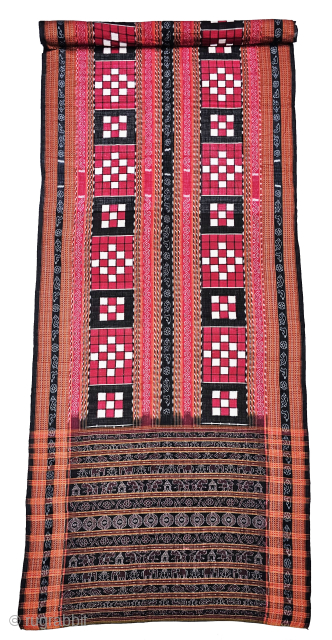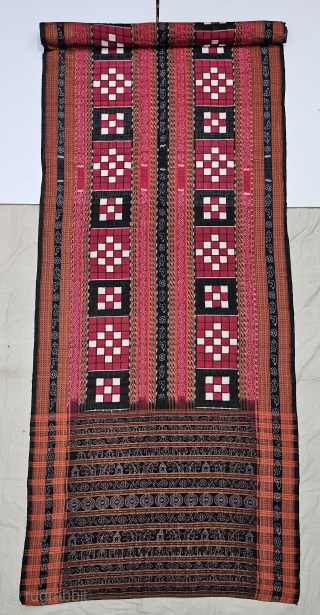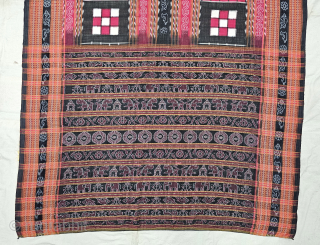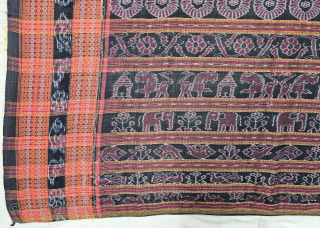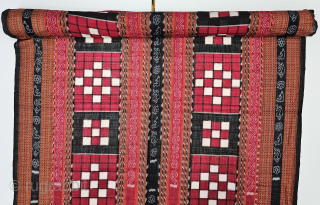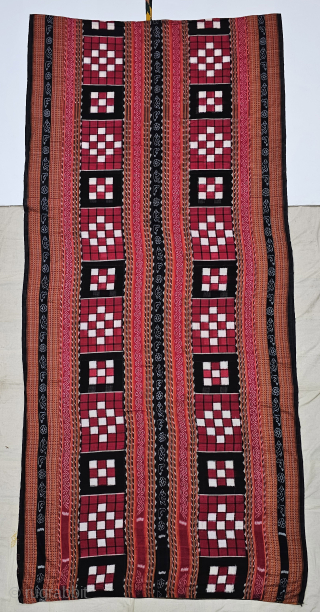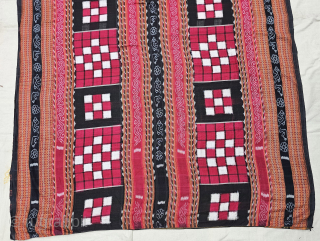Back
An Rare Cotton Dashphulia Saktapaar Domuha Saree From West Odisha.
Plain weave with compound and double ikat, supplementary warp and continuous supplementary weft
20th Century
120cm x 510cms
The checkerboard pattern in the field here is called pasapalli and forms the saptapadi or saktapaar genre of ikat sarees which are woven in Sambalpur,
The word saktapaar is vernacular for the board game widely known across India as the chaupar.
The double ikat pattern's striking similarity to those in telia rumal of the neighbouring States of Andhra Pradesh and Telangana brings to mind possible influences that may have occurred between the regions.
Single ikat is used to create the motifs of birds and animals as well as macho (fish) which are frequently seen in Odisha ikat sarees.
The fine stripes called danti (teeth-like) are brocaded, as are the ten rows of floral motifs in the borders on each side which are referred to as dasphulia. In this domukha version with two end panels, such border patterns morph from chevron to diamonds to fish to rudraksit (20240209_170423).
price:
On Request
- Home
- Antique Rugs by Region
- Category
- Profiles
- Post Items Free
- Albums
- Benaki Museum of Islamic Art
- Budapest: Ottoman Carpets
- Gulbenkian Museum
- Islamic Carpets. Brooklyn
- Islamic Textiles. Brooklyn
- Konya Museum: Rugs
- MKG, Hamburg
- MMA: Caucasian Carpets
- MMA: Mamluk Carpets
- MMA: Mughal Indian Carpets
- MMA: Ottoman Carpets
- MMA: Safavid Persian Carpets
- MMA: Turkmen Rugs
- McCoy Jones Kilims
- Ottoman textiles. Met
- Philadelphia Museum
- Rugs and Carpets: Berlin
- Seljuqs at the Met
- TIEM, Istanbul: Carpets
- V&A: Classical Carpets
- Vakiflar Carpets: Istanbul
- Baluch Rugs: Indianapolis
- Gallery Exhibitions
- Jaf an Exhibition
- Alberto Levi Gallery
- Andean Textile
- Christie's London: 2016
- Francesca Galloway
- HALI at 40
- ICOC Washington, DC 2018
- Jajims of the Shahsavan
- London Islamic Week April, 2018
- Mongolian Felts
- Navajo Rugs: JB Moore
- Persian Piled Weavings
- SF Tribal & Textile Art Show 2020
- SF Tribal 2019
- Sotheby's: C. Alexander
- Turkish Prayer Rugs
- Turkmen Main Carpets ICOC 2007









